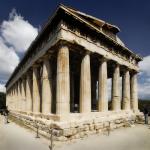|
This section contains 1,911 words (approx. 7 pages at 300 words per page) |

|
The Realm of Terpsichore.
Dance belonged to what the Greeks called mousike, the arts of the Nine Muses, the daughters of Zeus. Four of them—Polyhymnia, Calliope, Euterpe, and Erato—gave poets inspiration; Melpomene presided over the theater of tragedy, and Thalia, the theater of laughter; Urania marked the movements of the stars and planets; and Clio preserved the memories and myths of the past. Chief of them all, however, was Terpsichore, sovereign of the dance. Dance had a place in festivals, religious rituals, productions in the theater, entertainment at banquets, education of the young, and military training. The sway of Terpsichore extended over all movements of the body, including acrobatics, and in particular, gestures of the hands and arms—what the Greeks called kheironomia. Modern knowledge of ancient dance comes from widely scattered sources: paintings on vases, inscriptions carved on stone, and references...
|
This section contains 1,911 words (approx. 7 pages at 300 words per page) |

|




